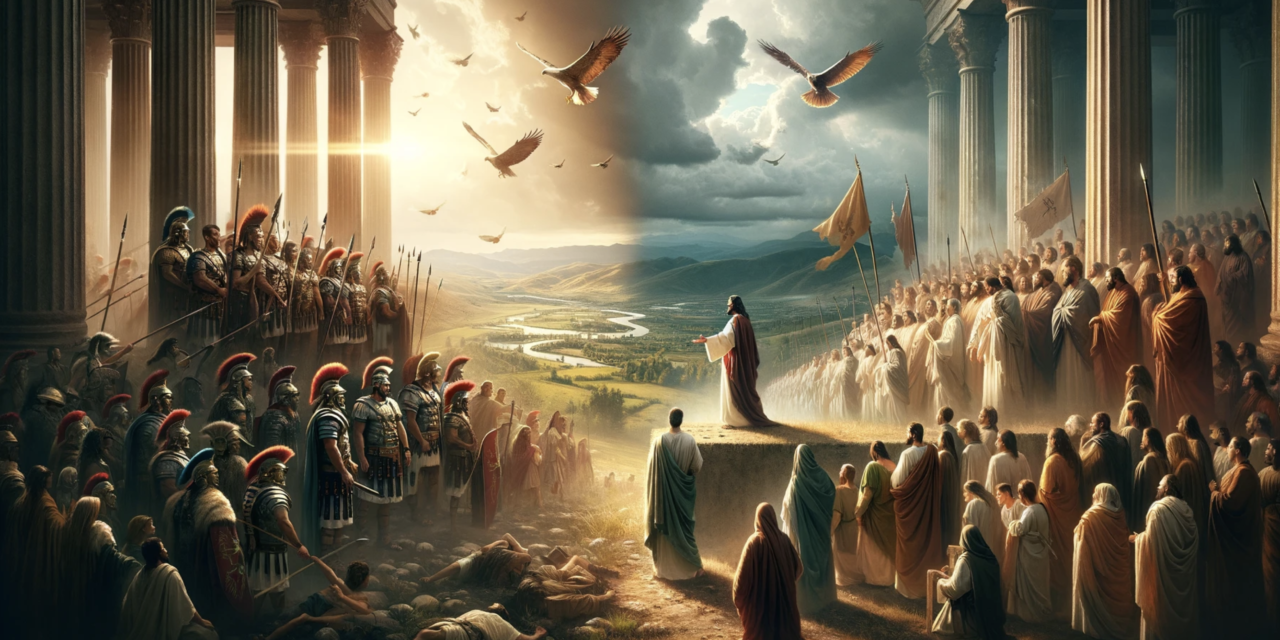The Historical Jesus
The figure of Jesus of Nazareth stands at the intersection of profound historical currents. To comprehend the man and the message, one must traverse the terrains of ancient Judaism, Hellenistic philosophy, and the might of Roman governance.
The Jewish Context
Roots in Ancient Traditions
Jesus emerged from a tradition rich in history, where the Hebrew Bible was not merely scripture but also a national heritage that captured the ethos of an entire people.
- Ancestral Covenant: The foundations of Jewish religious and social practices can be traced back through a millennium. The Pentateuch, with its laws and stories, binds the community, and informs their understanding of divine covenant and justice.
- The Prophets and The Writings: The voices of the prophets resonate through the ages, critiquing, guiding, and sometimes condemning the people and their leaders. The Writings, with their wisdom literature, poetry, and narratives, offer a window into the soul of a people and their relationship with God.
The Kingdoms and Exiles
- United and Divided Kingdoms: The history of Israel is a saga stretching from the heights of the united monarchy under David and Solomon to the trauma of the Assyrian and Babylonian exiles, which profoundly shape the collective memory of the people.
- Restoration and Second Temple: The narrative of return and restoration under Cyrus the Great provides a backdrop for understanding the Second Temple era, with the temple itself a symbol of identity and divine presence.
Hellenistic Confluence
Alexander’s Legacy
- Judea and Hellenism: The conquests of Alexander the Great in 333 BC thrust Judea into the Hellenistic World, grafting onto it a layer of Greek language and governance, yet the Jewish culture persists resiliently underneath.
- Antiochus IV Epiphanes: On Alexander’s death, Judea became part of the Empire of the Ptolemies until in 200 BCE, when Seleucid King Antiochus III seized Judea from Egypt’s control. The attempt by his descendent Antiochus IV Epiphanes to turn Jerusalem into a Hellenistic “polis”, sparked a successful revolt by Judas Maccabeus, and the establishment of independent rule for Judea until its annexation by Rome under Herod the Great.
Language and Learning
- Greek and Aramaic: With Greek as the lingua franca and Aramaic the heartbeat of the populace, Judea becomes a land of dual languages, reflecting the fusion of cultures.
Roman Rule and Rebellion
Herodian Rule and Roman Dominion
- A Land Under Rome: Herod the Great’s alliance with Rome brings about an era of architectural grandeur and political unrest, setting the stage for the world into which Jesus is born.
Tyranny and Taxation
- The Iron Fist of Rome: The Roman rule is characterized by its brutal tyranny, an external force imposing its will through local proxies. Taxation is not just an economic burden but also a symbol of oppression and exploitation.
The Jewish Response
- Revolts and Repercussions: The Jewish revolt of 70 AD against this backdrop of subjugation and the subsequent crushing response by the Roman army is a defining moment, shaping the religious and political landscape that the early Christian message navigates.
Jesus of Nazareth: Reformer and Revolutionary
The Historical Jesus
The scholarly consensus affirms the historical existence of Jesus and his death by crucifixion—a mode of execution reserved for the most severe offenders in Roman eyes. Despite this, his life’s work was not a call to overthrow Judaism, but to reform it from within.
- Reforming from Within: Jesus likely viewed his mission as a reform of Judaism rather than the foundation of a new religion. His message and actions were deeply rooted in Jewish tradition and the scriptures he knew intimately.
- Symbolism of the Twelve: Selecting twelve disciples was a deliberate nod to the twelve tribes of Israel, indicating a restoration of a united Israelite community.
- A Threat to the Status Quo: Through actions like his entrance into Jerusalem (celebrated on Palm Sunday) and his cleansing of the Temple, Jesus was perceived as a disruptive force, challenging not only the religious authorities but also the precarious peace maintained under Roman occupation.
- Political Undertones: Both Roman and Jewish Temple authorities had reasons to view Jesus as a threat, given his growing influence and radical teachings. This shared hostility set the stage for the fateful decision to put him to death.
The Significance of Crucifixion
Crucifixion was not just a death sentence; it was a public spectacle meant to humiliate and serve as a deterrent. Understanding this method of execution is crucial to grasping the gravity of Jesus’s fate and the depth of his followers’ courage.
- A Humiliating End: The process was designed to be excruciating and degrading, symbolizing a punishment for those who dared to rise above their station.
- A Display of Power: Bodies were often left as carrion for birds, a gruesome reminder to the populace of the might of Rome. Relatives were sometimes forced to witness this slow death, adding psychological torment to physical agony.
- Historical Precedents: The rebellion led by Judas ben Hezekiah and the subsequent mass crucifixions under Varus would have been fresh in the collective memory of the Judean people, including Jesus and his disciples.
- The Literal Cross: When Jesus spoke of taking up the cross, it may have been more than metaphorical—it was an invitation to confront the very real possibility of suffering the same brutal fate as Rome’s enemies.
The Spread of Christianity and the Early Church
Disagreements Among the Apostles
The early days of Christianity were marked by intense debates among the Apostles regarding the direction of the faith, particularly concerning the inclusion of Gentiles.
- The Gentile Question: The Apostolic dilemma over whether Gentiles must adopt Jewish customs to embrace the Christian message underscored early theological and cultural rifts.
- Pauline Mission: Paul’s advocacy for a Christianity inclusive of Gentiles without the prerequisite of Jewish conversion was revolutionary, sparking disputes with other Apostles.
- Peter’s Revelation: An account of Peter’s vision and his subsequent interaction with a Roman Centurion exemplified a transformative moment, signaling a broadened mission that would extend beyond Jewish communities.
Paul’s Missionary Journeys
Paul’s travels across the Mediterranean were instrumental in the dissemination of Christian teachings, establishing fledgling communities and expanding the church’s reach.
The Early Church Structure and Practices
The nascent church developed its own social structure and rituals that would lay the foundation for future Christian practice.
- Leadership Roles: With elders and deacons at the helm, the early church began to establish a governance model that would evolve over time.
- Role of Women: Contrary to many contemporary social structures, women held prominent roles within the early church organization.
- Communal Worship: These communities met weekly, often in the homes of wealthier patrons, to share in meals, study the apostolic letters, and worship together, fostering a sense of shared belief and communal identity.
Evolution of the New Testament
The books of the New Testament were not written in the same sequence chronological as the order in which they are published. Scholarship generally agrees that the earliest documents, written between 50 and 70 AD were the seven genuine letters of St Paul; 1 Thessalonians, Galatians, 1 Corinthians, Philemon, Philippians, 2 Corinthians and Romans. The first Gospel, Mark, followed in the 70s. The last book to be written was 2 Peter, probably in the 130s. During this period, there was significant development in church teaching, and church practice, as the early church spread throughout the commercial centres of the Roman Empire.
Against Empire?
The early Christian message stood in stark contrast to Roman imperial ideology.
- Jesus’ Titles and the Empire: Titles attributed to Jesus, such as ‘King of Kings and Lord of Lords’ or ‘Son of God’, were in direct contention with those claimed by Roman Emperors, suggesting an underlying resistance to imperial authority.
- Pax Romana vs Pax Christi: At the heart of the early church’s message was a sharp distinction between the Roman understanding of ‘peace’ (Pax Romana) and the peace of God as summarised by Jesus (Pax Christi). Rome valued peace through force, order through domination and calm through suppression. Jesus preached about peace through justice, order through mutual service and calm through the dignity of every person.
- Revelation as Political Allegory: The Book of Revelation presents a vivid anti-imperial vision, drawing parallels with the Book of Daniel’s stance against the Seleucid Empire. It articulates a call for Christians to remain steadfast in their faith amidst the prevailing Roman hegemony.
Christianity and Rome: Conflict and Confluence
Diverse Roots of Early Christianity
Early Christianity was not a monolith but a tapestry of varied theological and cultural strands, with major centres like Carthage and Alexandria contributing unique perspectives to the Christian discourse.
- Carthage: A city with a Phoenician heritage and Latin language, where notable Church Fathers like Tertullian and Augustine articulated doctrines that would shape Western Christianity.
- Alexandria: A Hellenistic city, where Greek thought permeated Jewish teachings, reflected in the works of Philo and the Septuagint, and where early theological giants like Clement and Athanasius contended with emerging heresies.
Persecutions: The Fire and the Faith
From its inception, Christianity faced opposition from various fronts, leading to a series of persecutions that tested the resilience of the nascent faith.
- Jewish and Roman Hostilities: The initial Jewish-Christian tensions and the Roman crackdowns, including the devastation of Jerusalem and the Bar Kochba revolt, set an early precedent for the struggle between Christianity and the prevailing powers.
- Empire-Wide Persecution: Under emperors from Nero to Diocletian, Christians faced sporadic yet brutal repressions, culminating in the Great Persecution, which sought to extinguish the Christian presence.
The Constantine Shift
The ascent of Constantine marked a seismic shift in the Christian experience, from persecution to imperial patronage.
- Constantine’s Conversion: His purported vision and subsequent victory marked the beginning of Christianity’s transition from a persecuted sect to a state-favoured religion.
- Edict of Milan and Beyond: The legal recognition of Christianity and the summoning of the Council of Nicaea set the stage for its evolution into an institutionalized religion aligned with the Empire.
The Search for Orthodoxy
In the quest for doctrinal unity, early Christianity grappled with diverse understandings of Christ’s nature, leading to the formation of various theologies and the convocation of ecumenical councils.
- Heresies and Councils: Arianism, Macedonianism, Nestorianism, Monophysitism, and Monothelitism represent the spectrum of debates regarding the divine and human aspects of Jesus, debates which would occupy the church for centuries.
The Fall of Rome and Christianity’s Survival
As the Western Roman Empire succumbed to invasions and internal decay, Christianity not only survived but continued to consolidate, adapting to the changing political landscape.
- Barbarian Invasions and the Empire’s Demise: The Sack of Rome and the subsequent invasions signalled the end of an era, while figures like Theodoric and Justinian sought to preserve and restore the glory of Rome.
Terry Cooke-Davies
27 April 2024
Special thanks to the AI assistance provided by Perplexity AI, and by ChatGPT (4) from OpenAI in shaping this article.

CLICK HERE
To view: “Christendom and Science: A Brief Overview of a Complex Topic.” The summary of a discussion in January 2023 on the rise and fall of Christendom, and its relationship to the rise of the scientific method.

Link to Discussion Resources
Click here to view the resources such as PowerPoint Slides, handouts, and links to a video and books that supported this discussion by the Science, Philosophy, and Spirituality group within Shepway and District u3a.






